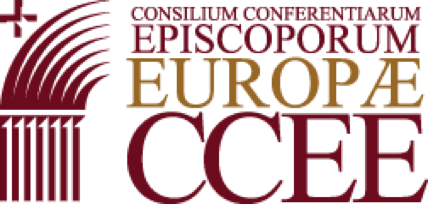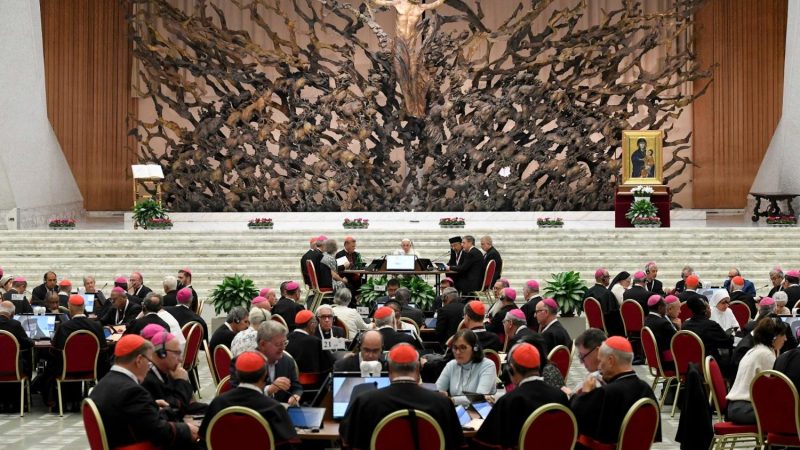With the Mass celebrated on 4 October by Pope Francis in St. Peter’s Square, together with the new Cardinals created the College of Cardinals in the Consistory of 30 September, the 16th Ordinary General Assembly of the Synod of Bishops began.
The synodal assembly, entitled “For a synodal Church: communion, participation and mission”, is the first stage of a journey that began in 2021 with the diocesan and national consultation followed by a continental stage. For Europe, the continental stage of the Synod was held in Prague from 5 to 12 February 2023, organised by the CCEE.
On 30 September, the ecumenical prayer vigil, “Together – Gathering of the People of God”, organised by the Taizé Community, saw many young people arrive in St Peter’s Square to pray for the Synod, together with Pope Francis, heads of Churches, and the leaders and delegations from the different Christian traditions. After the vigil and until 3 October, the members, delegates and special envoys to the Synod met at the Fraterna Domus in Sacrofano for a spiritual retreat with meditations by Fr. Timothy Radcliffe, a Dominican, and Mother Ignazia Angelini, a Benedictine.
The protagonist of the Synod is the Holy Spirit, said the Pope in his homily at the opening Mass. “We are not here to form a parliament but to walk together with the gaze of Jesus, who blesses the Father and welcomes those who are weary and oppressed. So let us start from the gaze of Jesus, which is a blessing and welcoming gaze”.
A gaze of the Lord that invites us “to be a Church that, with a glad heart, contemplates God’s action and discerns the present. And which, amid the sometimes agitated waves of our time, does not lose heart, does not seek ideological loopholes, does not barricade itself behind preconceived notions, does not give in to convenient solutions, does not let the world dictate its agenda”.
The primary task of the Synod, continued Pope Francis, is “to refocus our gaze on God, to be a Church that looks mercifully at humanity. A Church that is united and fraternal – or at least seeks to be united and fraternal –, that listens and dialogues; a Church that blesses and encourages, that helps those who seek the Lord, that lovingly stirs up the indifferent, that opens paths in order to draw people into the beauty of faith. A Church that has God at its centre and, therefore, is not divided internally and is never harsh externally. A Church that takes a risk in following Jesus. This is how Jesus wants the Church, his Bride, to be”.
In the afternoon, in the presence of Pope Francis, the first General Congregation was held in the Paul VI Audience Hall. Cardinal Mario Grech, General Secretary of the Synod, in his introductory greeting, after wishing the Pope well on the feast of St Francis of Assisi, stressed that the urgent challenge for the Church at this moment in history is how to “become a sign and instrument of God’s love for every man and woman”. “God’s love is the medicine that can heal today’s wounded humanity, and as the Church our mission is to be a sign of this love. Many people are in search of the meaning of life and joy, and implore the Church to show them the beautiful and merciful face of Jesus”.
Church and Synod, recalled Cardinal Grech, are synonyms and to be a synodal Church means to be “a Church of listening”, “listening to the Word of God, in the light of Tradition, to understand God’s will for today”. A synod that, for the first time, sees as full members of the assembly not only bishops but also presbyters, deacons, men and women religious, laymen and laywomen.
Cardinal Jean-Claude Hollerich, Synod rapporteur, described the synodal process as a “learning of the grammar of synodality”, a grammar that changes over time like that of our languages but that has rules that never change: “the dignity that comes from Baptism; Peter’s role in the Church; la episcopal collegiality; the ordained ministry, the common priesthood of the faithful and the fact that they are ordained to one another”. “With these fundamental elements of our Catholic grammar”, he continued, “we must find ways to express the new insights that the Holy Spirit gives us”.
He then illustrated the working method for the coming weeks, divided into four modules dedicated to discernment and a fifth to discussion. In continuity with the synodal path started in 2021, the work of the smaller circles will follow the method of “conversation in the Spirit” to allow each participant to express his or her point of view. At the end of the work, the aim is to draw up a road map for the coming year aimed at indicating the points on which consensus has been reached and those on which deeper reflection is needed.
The first part of the synodal assembly will end on 29 October, with the solemn closing Mass, and the drafting of a synthesis report. The second part of the synod will be held in October 2024, and will lead to the approval of a final document and, possibly, a post-synodal exhortation by the Pope.
Photo: vaticannews.va

